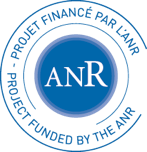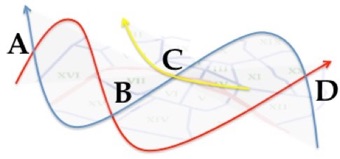ANR ABCD PROJECT
UPMC (coordinator)
UPMC represents French excellence in science and medicine. A direct descendant of the historic Sorbonne, UPMC is the top French university by the Shanghai world rankings, 6th in Europe and 35th in the world. UPMC encompasses all major sciences, such as mathematics (4th in the world); chemistry; physics; electronics; computer science; mechanics; Earth, marine and environmental sciences; life sciences; and medicine.
With 8,000 publications per year, which is approximately 11% of the national production, UPMC is a major player in the international knowledge and innovation economy, as shown by its many international awards. The University has more than 3,750 professor-researchers in 100 laboratories in partnership with four French national research organizations: the CNRS (science), Inserm (health and medical), the IRD (development) and Inria (computing and automation). UPMC files more than 20 patents each year and has cooperation agreements with prestigious universities worldwide. Its partnerships with major French and international research organizations and participation in various international networks are testament to the University’s international involvement.
The Computer Science department LIP6 participates with its PHARE research group in telecommunications and Cloud networking.
Contacts: Rami Langar, Stefano Secci
UCOPIA
Founded in 2002, UCOPIA was the brainchild of high-level research at the world-renowned Pierre and Marie Curie University in Paris and the vision brought by the founders: Didier Plateau, Guy Pujolle, Stephen Cunningham and François Bancilhon. UCOPIA spent its early years nurtured by Professor Pujolle and his LIP6 research team of R&D engineers and doctorate students. The four founders brought to the table a significant entrepreneurial and technological experience gained through several successful business creations in the fields of software, Internet and cable television. In 2004 UCOPIA started commercial operations with a mature product and well-prepared for the world market. In a short time, the small French team has become a respected leader in the European guest access market with over 10,000 solutions deployed around the world.
UCOPIA has grown a solid network of resellers and distributors worldwide and and from its headquarters in Paris now manages operations in Denver, London, Milan and Köln. With over 450 million users connected on UCOPIA portals last year alone and a steady financial growth of 50% year over year, UCOPIA’s place as a Pure Player in access management is secure. UCOPIA has managed to hold on to its academic roots and small-team feel albeit it’s growing numbers. Its values of academic excellence, team spirit and technical merit are as ever-present today as they were when it began.
Contacts: Patrick Borras, Badis Tebbani
Orange
Orange is one of the world’s leading telecommunications operators with annual sales of 41 billion euros and has 165,000 employees worldwide. Present in 30 countries, the Group has a total customer base of 236 million customers, including 178 million mobile customers and 15 million fixe broadband internet (ADSL, fiber) customers worldwide. Orange Labs (previously France Télécom R&D) represents the Orange Group’s global innovation network entity which anticipates technological revolutions and imagines tomorrow’s technologies. It reflects the Group’s ambition to put perpetual innovation at the heart of its strategy, firmly focused on its clients. As the principal source of innovation for the Group, it holds more than 7,500 registered patents. Consisting of 3,600 researchers in 17 laboratories on four continents (8 in France and 9 in Europe, America, Africa and Asia), its scope and coverage enable it to detect all technological breakthroughs and encourage partnerships. Orange Labs extensively collaborates with operators, manufacturers, universities and other R&D centres. Besides steady contributions to open source activities (OpenStack, OPNFV, …), Orange is actively involved in standardisation and regulation bodies such as 3GPP, ETSI and ITU-R.
Contacts: Zbigniew Smoreda, Cezary Ziemlicki
INSTITUT MINES TELECOM – Télécom ParisTech (TPT)
Telecom ParisTech (part of the Institute Mines-Telecom) is the first higher education institution completely focusing on telecommunications, and through the years has acquired a level of excellence internationally recognized in the field of Communications and Information Technology. With 215 faculty members, twenty research associates and approximately 320 graduate students, Télécom ParisTech is a leader in the French public research in the field of Information and Communication Technology (ICT). Telecom ParisTech in partnership with the CNRS (Centre National de la Recherche Scientifique) constitutes one of the largest mixed research unit (UMR – LTCI 5141) in the domain of LTCI (Sciences et Technologies de l’Information et de la Communication). The main research activities of Telecom ParisTech focus on: communication systems (algorithm, architecture, physical layer, optoelectronic, microwave); signals and images processing (detection, restoration, compression, recognition and interpretation of images of speech and music); computer networks (IP, embedded systems, human-computer interaction, virtual reality, artificial intelligence and information management); economics, management and social sciences (digital business and administration, policy and regulation, sociology of uses).
Contacts: Christian Licoppe, Julien Morel
INRIA Lyon
Inria (Institut National de Recherche en Automatique et Informatique) is the major French National academic institution in Computer Science and Control. Inria will participate to the Project from its Research Centre from Lyon; more specifically, all activities related to this project will be carried out inside the Urbanet research team. The objective of the team is to contribute to the study of capillary networks over three directions: characterize urban networks, develop and evaluation protocols used in these contexts, and optimize the infrastructure usage.
Contacts: Razvan Stanica, Marco Fiore
Consortium




